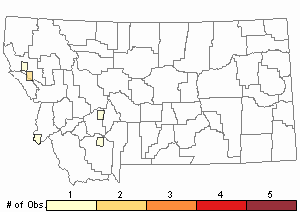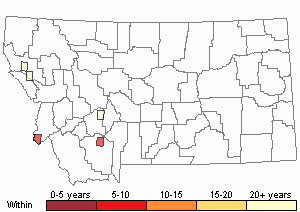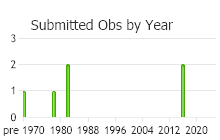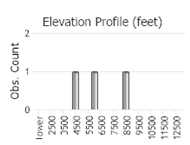View in other NatureServe Network Field Guides
NatureServe
Montana
Utah
Wyoming
Idaho
Wisconsin
British Columbia
South Carolina
Yukon
California
New York
Spiny Dry Rock Moss - Grimmia laevigata
Other Names:
Spiny Black Rock Moss
General Description
Plant: Hoary, dense tufts. Dark green to dark brown. Stems 0.5-2.0 cm tall.
Leaf: Oblong-ovate to oblong-lanceolate, 1.5-3.0 x 0.4-0.6 mm. Awn 0.3-2.0 long, broadly attached and decurrent. Some leaves without awns; at least the upper leaves are awned and straight. Both margins plane. Costa ends before apex, is weak, and is wide at leaf base.
Leaf Cells: Basal laminal cells near costa are elongate, straight, thick-walled laterally, and green. Basal laminal cells near margin are oblate to quadrate, straight, thick-walled transversely, thin-walled laterally, and green. Median laminal cells are quadrate to rounded, straight, and thick-walled. X-S: distal laminal cells are 2-layered, thick-walled, and quadrate. Costa X-S: distally a semi-circular in outline (keeled).
Range Comments
Canada: BC; USA: AL, AZ, AR, CA, CO, DC, FL, GA, ID, IL, IN, IA, KS, KY, MD, MA, MN, MO, MT, NE, NV, NJ, NM, NY, NC, OK, OR, PA, SC, SD, TN, TX, UT, VT, VA, WA, WY; Mexico; South America; Eurasia; Africa; Indian Ocean Islands; Australia (FNA 2007). In Montana: Flathead, Jefferson, Lewis and Clark, and Sanders Counties (Elliott 2016).
Observations in Montana Natural Heritage Program Database
Number of Observations: 6
(Click on the following maps and charts to see full sized version)
Map Help and Descriptions
Relative Density

Recency



 (Observations spanning multiple months or years are excluded from time charts)
(Observations spanning multiple months or years are excluded from time charts)
Habitat
Exposed acidic granite, sandstone, and basalt rock. Humid to dry areas in the plains and montane zones, but rarely in the alpine. Moderate to high elevations (650 – 9200 feet). It occurs in the Rocky Mountains, but is not common and is mostly present at lower elevations on the east slopes.
Reproductive Characteristics
Dioicous. Seta is 1.5-3.0 mm tall, straight, and centrally attached to capsule. Capsules are occasionally found, exserted, brown, oblong-ovoid to cylindric.
Gemmae absent on leaves.
Stewardship Responsibility
References
- Literature Cited AboveLegend:
 View Online Publication
View Online Publication Elliott, J.C. and A.K. Pipp. 2018. A Checklist of Montana Mosses (1880-2018). Updated 3 January, 2020. Montana Natural Heritage Program, Helena, Montana. 73 pp.
Elliott, J.C. and A.K. Pipp. 2018. A Checklist of Montana Mosses (1880-2018). Updated 3 January, 2020. Montana Natural Heritage Program, Helena, Montana. 73 pp. Flora of North America Editorial Committee, eds. 2007. Flora of North America North of Mexico. Volume 27. Bryophytes: Mosses, Part 1. Oxford University Press, Inc., NY. xxi + 713 pp.
Flora of North America Editorial Committee, eds. 2007. Flora of North America North of Mexico. Volume 27. Bryophytes: Mosses, Part 1. Oxford University Press, Inc., NY. xxi + 713 pp.
- Additional ReferencesLegend:
 View Online Publication
View Online Publication
Do you know of a citation we're missing? Elliot, J. C. 1993. Second checklist of Montana mosses. Unpublished report. U.S. Forest Service, Region 1. Missoula, MT. 45 pp.
Elliot, J. C. 1993. Second checklist of Montana mosses. Unpublished report. U.S. Forest Service, Region 1. Missoula, MT. 45 pp. Lawton, E. 1971. Keys for the Identification of the Mosses on the Pacific Northwest. Reprinted from 'Moss Flora of the Pacific Northwest'. Published as Supplement No. 2 of the Journal of the Hattori Botanical Laboratory. Nichinan, Miyazaki, Japan. 66 pp.
Lawton, E. 1971. Keys for the Identification of the Mosses on the Pacific Northwest. Reprinted from 'Moss Flora of the Pacific Northwest'. Published as Supplement No. 2 of the Journal of the Hattori Botanical Laboratory. Nichinan, Miyazaki, Japan. 66 pp. Lawton, E. 1971. Moss Flora of the Pacific Northwest. Hattori Botanical Laboratory. Japan: Yamabuki-cho, Shinjuku-ku, Tokyo. 362 pages plus appendices.
Lawton, E. 1971. Moss Flora of the Pacific Northwest. Hattori Botanical Laboratory. Japan: Yamabuki-cho, Shinjuku-ku, Tokyo. 362 pages plus appendices.
- Web Search Engines for Articles on "Spiny Dry Rock Moss"





